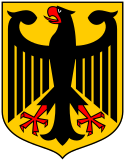Wybory prezydenckie w Niemczech w 1925 roku
| NiemcyTen artykuł jest częścią serii: Ustrój i polityka Niemiec Ustrój polityczny Konstytucja Władza ustawodawcza Władza wykonawcza Władza sądownicza Kontrola państwowa Finanse Samorząd terytorialny Partie polityczne Polityka zagraniczna | |
| Portal | |
Wybory prezydenckie w Niemczech w 1925 roku – odbyły się 29 marca i 26 kwietnia, po niespodziewanej śmierci prezydenta Friedricha Eberta. Zgodnie z konstytucją Republiki Weimarskiej prezydenta wybierali obywatele. Zwyciężył Paul von Hindenburg. Został wybrany na prezydenta w drugiej rundzie głosowania.
Wyniki
| Kandydat | Partia | I tura | II tura | ||
|---|---|---|---|---|---|
| Liczba głosów | Procent | Liczba głosów | Procent | ||
| Erich Ludendorff | NSDAP | 285.793 | 1,1 | - | - |
| Karl Jarres | DVP | 10.416.658 | 38,8 | - | - |
| Otto Braun | SPD | 7.802.497 | 29 | - | - |
| Wilhelm Marx | Zentrum | 3.887.734 | 14,5 | 13.751.605 | 45,3 |
| Ernst Thälmann | KPD | 1.871.815 | 7 | 1.931.151 | 6,4 |
| Willy Hellpach | DDP | 1.568.398 | 5,8 | - | - |
| Heinrich Held | BVP | 1.007.450 | 3,7 | - | - |
| Paul von Hindenburg | bezpartyjny | - | - | 14.655.641 | 48,3 |
| |||||||||||||
Media użyte na tej stronie
Autor: author unknown, Licencja: CC BY-SA 3.0 de
Cropped picture from a picture at wikimedia commons, donated by German Bundesarchiv. See File:Bundesarchiv_Bild_102-01176,_Heinrich_Held_(rechts).jpg for original.
Chancellor of Germany Wilhelm Marx, (see mirror-inverted handwritten dates on the top: 5/12/24 12/26/23)
Map of results for the second round of the 1925 German presidential election.
Willy Hellpach by Elli Lisser. In Zeitbilder (Beilage der Vossischen Zeitung 3/1931
Map of results for the first round of the 1925 German presidential election
(c) Bundesarchiv, Bild 102-01175 / CC-BY-SA 3.0
(c) Bundesarchiv, Bild 102-12940 / CC-BY-SA 3.0
Der Führer der deutschen kommunistischen Arbeiterpartei Thälmann, welcher als Kandidat für die Reichspräsidentenwahl aufgestellt wird.
Paul von Hindenburg, marszałek i drugi prezydent Rzeszy (zm. 1934)




















